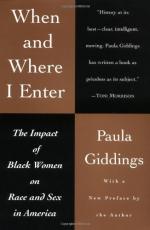
|
| Name: _________________________ | Period: ___________________ |
This test consists of 15 multiple choice questions and 5 short answer questions.
Multiple Choice Questions
1. Why did the magazine of the NAACP in 1919 state that Black women felt pride for Black men during the race riots?
(a) Because the Balck men had "stood like men."
(b) Because the Black men had "taken out the White man for once."
(c) Because the Black man had "not backed down from each other."
(d) Because the Black man had "stood up for the Black woman."
2. In what year was the first segregated YWCA chartered in Ohio?
(a) 1921.
(b) 1893.
(c) 1906.
(d) 1818.
3. According to the chapter "Black Braintrusters," where were the first Black aviators for WWII trained?
(a) Fort Knox.
(b) West Point.
(c) Quantico.
(d) Tuskegee.
4. How many Black branches of the YWCA were there by 1919?
(a) 11.
(b) 24.
(c) 49.
(d) 19.
5. In 1945, what percent of the American workforce was women?
(a) 76%.
(b) 38%.
(c) 54%.
(d) 14%.
6. How much could a young unmarried woman in domestic service in the North earn in a week during 1920?
(a) $4.00.
(b) $6.00.
(c) $3.00.
(d) $8.00.
7. During the 1920s, what rate shot up?
(a) Marriage rate.
(b) Divorce rate.
(c) Birth rate.
(d) Suicide rate.
8. How many lynching took place between 1919 and 1923?
(a) 179.
(b) 239.
(c) 100.
(d) 301.
9. By the end of 1935, how many northern cities had over 100,000 African-Americans in population?
(a) 2.
(b) 11.
(c) 17.
(d) 34.
10. Who was elected President of the United States in 1932?
(a) FDR.
(b) Harrison.
(c) Ford.
(d) Hoover.
11. What did the chapter "Toward Interracial Cooperation" name as the most "pressing reason to draw out the poison of racial antagonism"?
(a) Euqality.
(b) Welfare.
(c) Social justice.
(d) Economy.
12. Who was the first White woman named as executive director of the CIC?
(a) Jessie Daniel Ames.
(b) lillian Smith.
(c) Sonya Smith-Jackson.
(d) Willie Mae Alexander.
13. In 1935, what leader of the Texas state committee insisted that Texas Whites would object to an integrated Texas community?
(a) Lyndon B. Johnson.
(b) Martin B. Hidgins.
(c) Paul Minors.
(d) Dwight D. Eisenhower.
14. What show featured Black women singing arias from "Faust," "Rigoletto," and other operas?
(a) Saved.
(b) Classics on Stage.
(c) Octoroons.
(d) Metamorphsis.
15. What poet did Bethune hire as an assistant for her position as the Negro Affairs director?
(a) Langston Hughes.
(b) Jean Toomer.
(c) Zora Neal Hurston.
(d) Frank Horne.
Short Answer Questions
1. What, according to the chapter "Toward Interracial Cooperation," did Black women believe was essential to "racial harmony"?
2. What school did the Daytona School for Girls merge with?
3. Who was the YWCA's first Black secretary?
4. What was Mary McLeod Bethune riding aboard in 1927?
5. In 1916, what group launched a campaign to save the home of Frederick Douglass from default?
|
This section contains 411 words (approx. 2 pages at 300 words per page) |

|




